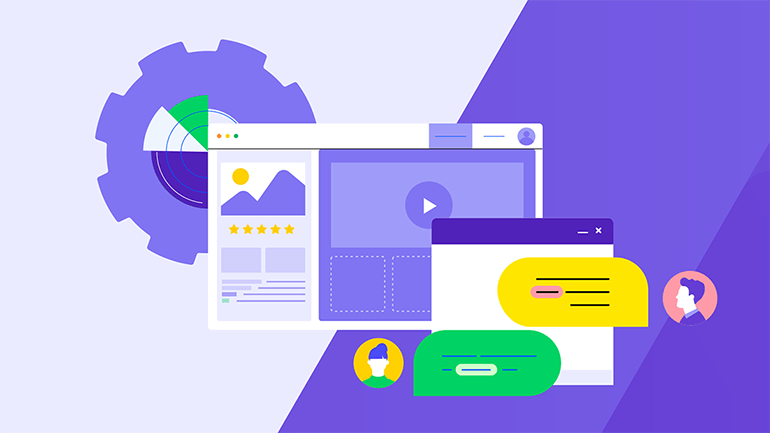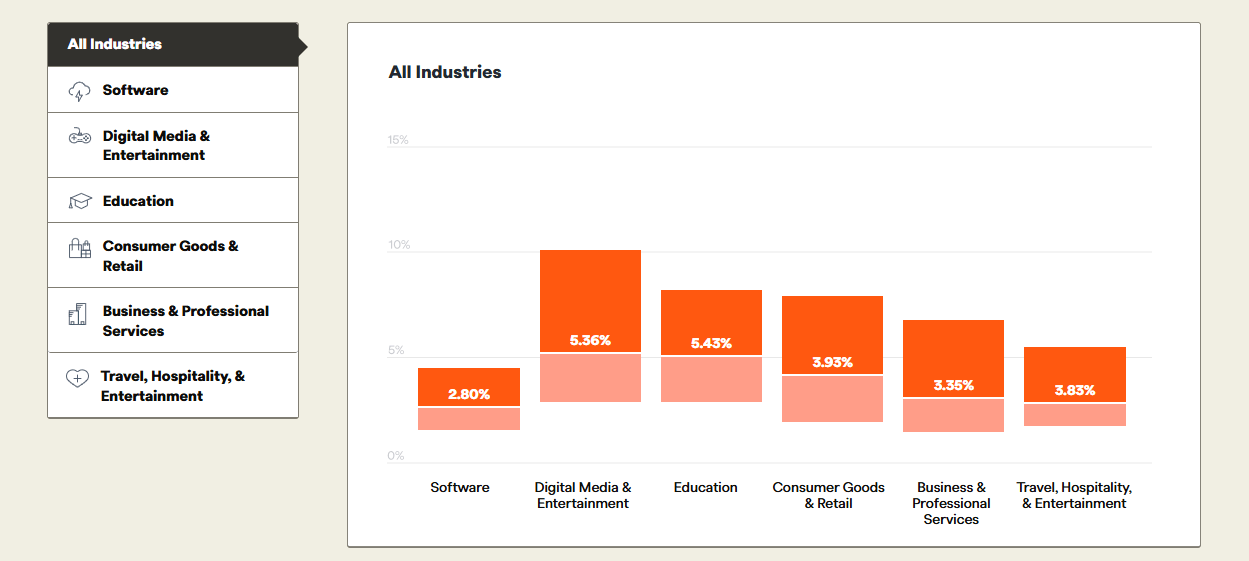What to Do When Your App’s User Churn Rate Is Too High

User churn rate is a metric that represents how many users have cancelled their subscription during a tracked time period. If it’s high, something has gone amiss. Here’s the process for turning it around.
There are a number of signs that something may not be quite right with an app you built. It could be that the user signup is too low, free trials rarely turn into active subscriptions, or the user churn rate is too high.
In this post, we’re going to focus on the latter.
Let’s talk about what it means to have a high user churn rate and steps to take once you’ve determined that you’re losing more users than you can afford to.
What Is User Churn?
User churn refers to the percentage of users that have terminated their subscription to an ongoing service or product. To calculate your user churn each month, use the following formula:
Number of Users Lost ÷ Total Number of Users You Started With × 100
Let’s say your app had 2,410 users on August 1. By August 31, you were down to 2,252. That’s a loss of 158 users. So, the formula would work out like this:
158 ÷ 2,410 × 100 = 6.6%
Now, if we’re just looking at customer churn rates, you’d be doing well in any industry, according to Customer Gauge data. Median churn rates in 2025 range from 11% in the Energy/Utilities sector to 56% in Wholesale.
But there’s a big difference between businesses that serve customers directly and on a one-off basis versus those who rely on a subscription or membership model. In that case, your app’s churn rate would be poor, according to data from Recurly.
For instance, here’s the 2025 data on median industry churn rate for various industries:

You can see how much lower the Software churn rate is than the (mostly) direct-to-consumer industries. The median is 2.80% for Software, with the highest quartile being around 1.78% (best performing) and the lowest being 4.80% (worst performing).
User churn in direct-to-consumer businesses can be high so long as they have substantial foot traffic to replace the lost business. Subscription-based enterprises, on the other hand, need to keep churn rates low as they’re not one-time losses.
A lost subscriber reverberates throughout the rest of the fiscal year for a subscription business model. So, those churn rates need to be as low as possible to keep revenue even and steady.
High churn rates aren’t just harmful to revenue generation. They are costly and time-consuming as businesses end up having to spend extra time trying to bring in new subscribers to replace the ones they lost. High user churn also correlates with negative word of mouth, which means more time spent monitoring and cleaning up your business’s reputation online.
Process for Reversing a High User Churn Rate
Whether your user churn rate is too high or you’re simply wanting to get it lower than it already is, here’s the process to help you reverse it:
Step 1: Identify the Problem
When there’s high user churn, it means that once-interested users have changed their minds. But why? This is going to be the first thing you need to work out.
What you need to know is this:
- When in the user journey does this problem seem to happen?
- Which type of user does it happen to most?
- Why is it happening (or why do you think it is happening if you don’t have direct user input)?
- What exactly is the user’s breaking point and can it be fixed?
- Anything else of relevance?
If you’re not sure where to start, here are some reasons why this could be happening in droves:
Scenario #1: Your marketing and sales are misleading. So once users subscribe and start using the app, they realize it’s not what was promised.
If your user churn commonly takes place within the first month, this could be why.
Scenario #2: Onboarding is much more difficult or time-consuming than expected. Or it seems like too much work compared to the value offered by the app.
This is another one where you’ll see the highest user churn rates in the first couple of months.
Scenario #3: Customer support may be insufficient or nonexistent. When users pay a premium for an app, they generally don’t expect to figure it out by themselves, even if it’s a relatively simple solution.
If you can review activity logs prior to user churn, see how common it is for them to use your self-support options like documentation or to reach out to support prior to cancellation.
Scenario #4: Some users sign up and hit the ground running with your app. Others, not so much.
Review your user segmentation and see if this issue appears within a certain segment vs. another. Or if, perhaps, the users that churn don’t fall within one of your segments. If so, your app may be attracting and converting users who are all wrong for it.
Scenario #5: Your customer support team has been receiving a lot of questions about a certain feature. Your app doesn’t currently offer it, but the primary competitors all do and users want to know when they’ll have the same capabilities.
If your user feedback and requests revolve around lacking features, it could be as simple as that.
Scenario #6: Of the 10 most commonly visited pages on your website, three of them are documentation pages related to bugs. Your customer service team has been spending a lot of time troubleshooting bugs lately as well.
If your app suffers from various bugs at any given time, the unreliability could be a huge factor in your churn rate.
Step 2: Validate the Issue
Your app metrics will help you determine that this isn’t just a gut feeling and that your user churn rate is high. The info you gather from customer support interactions, bug reports and other sources may help shed some light on what the problem is.
That said, you don’t want to go fixing a problem until you actually know it’s the source of your high churn rate. And if it’s not something you can witness yourself—like a buggy or broken feature set—then you’re going to need to get that input from your users before they churn.
There are a number of user research methods you can use to dig around and find out what’s going on.
Here are some methods that might be helpful:
User Surveys
This is a quick and easy way to gauge how users feel about your app (or a process within it). For instance, you could show a survey in the dashboard 30 days after they sign up. You could email it to them as well.
On a scale of 1 to 10, how would you rate your experience with [our app] so far?
Another good time to share a survey would be as they’re canceling their subscription. This one would give them a multiple choice question to answer, like:
What’s the reason for your cancellation?
You could include reasons like Price, Switched to Another App, Bugs & Errors, etc.
You could also include an open-ended field at the end and invite them to leave more information about their experience. You might even ask them to include their email or phone number if they’d like, and then have someone reach out to ask them more about their experience.
This would be a great way to 1) show them you care, 2) deter them from leaving a negative review and 3) encourage them not to cancel after all.
User Interviews
These one-on-one interviews are a great way to get a true sense for what the experience has been like for your users. You’ll need to interview a substantial number of users in order to start identifying patterns and trends.
That said, the information you get from these live calls will be invaluable.
I recently did a series of these for a client and discovered not only the top reasons why users were abandoning the app, but also the top reasons that kept them from cancelling. We were then able to use this information to create a short list of updates for the development team to work on. At the same time, I was able to use their positive feedback to reshape our marketing campaigns so that we were highlighting what truly made the app so valuable for the users.
Usability Testing
While I’m a big fan of passive research methods like eye-tracking studies, you don’t have a ton of time to spare when your churn rate is high. Instead, try this active feedback collection method.
With usability testing, you’ll ask real users to complete a number of tasks. These tasks should be related to parts of your app that you suspect are creating the most friction in the experience—things like onboarding, core features and so on.
While you could do these tests unmoderated, it’ll be more helpful to moderate them so you can talk to the users in real time. Or, rather, have them communicate their thought process and reactions as they complete the tasks.
While I was conducting my user interviews, this was something many of the users initiated themselves. A number of them kept trying to explain a problem they were having with some AI features. While I knew what they were talking about, they still insisted on sharing their screens so I could “feel” what they were going through.
It definitely helped me see how the app’s bugs weren’t just impeding their work, but driving them to have such an emotional response. When your users get to that point, any little misstep or inconvenience can feel overwhelming and leave them feeling like it’s time to give up. So it’s good to understand it from their perspective, so you know exactly what to fix.
Step 3: Experiment with Implementing an Alternative
If the issue is something like a bug, there’s no alternative to test out. The bug or error should be resolved ASAP.
However, let’s say the issue is related to one of the following:
- Incongruency between marketing and the true app experience
- Dissatisfaction with app pricing and perceived value
- Quality of customer support
- Onboarding struggles
- Usability issues
- Too many features hiding behind next paywall
- Missing key features that competition has
In these cases, it would be a good idea to test out alternatives to see if they make a difference first.
For example, let’s say that users are surprised by what the app is like after they sign up. If you don’t already have a demo they can play around with or a free demo and consultation call, try it out. While you may get fewer signups, that could be a good thing if your user churn rate goes down.
Adjusting your marketing messaging and targeting could also help with this. If expectations don’t align with reality, then there’s something that needs to be fixed leading up to conversion.
If your issues relate to the functionality of the app itself, experiment with small changes. Carefully monitor user engagement and churn for a couple weeks to see how they respond.
Similar to A/B testing, you’ll want to make one small change at a time to verify that other factors haven’t contributed to the positive (or negative) response. Once you find a winning solution, officially implement it into the app experience and move onto the next problem area.
Throughout this process, keep an eye on all your metrics. While the goal is to lower the user churn rate, you want to make sure other performance indicators stay high with regards to login frequency, feature usage, user satisfaction and so on.
Step 4: Repair the Rest of the UX
High user churn can be a great opportunity to flesh out what your app does, how it works, who it serves and how you market it. Once you’ve sorted out the biggest issue leading to churn, take those insights and use them to update other aspects of the user experience—not just in the app, but outside of it as well.
For instance, let’s say the onboarding experience was overly simplified. There’s nothing wrong with having a complex app that deals with a complex solution. However, if users are being led to believe it’s fast and easy to get started with the app, and then discover very quickly it’s not, that needs to be remedied.
So, you’ve gone through and fixed the onboarding process. It’s now much more descriptive and includes helpful video tutorials that guide users through completing their first steps. You also added chatbot and 24/7 customer support links so users don’t feel like they’ve been thrown out to sea without a life jacket.
Things seem to be improving churn-wise. What’s next?
Well, setting clearer expectations much earlier on would be useful. So, you’d want to take a look at your website and marketing material.
The messaging should be reworked so it accurately explains the solution and what it’s like to use it. You don’t need to say, “This app has a huge learning curve! Users beware!” But perhaps adding five-minute or less videos that show someone actually using the app would be useful. That way, users can determine for themselves if they’re up to the challenge.
Incorporating accurate customer testimonials and case studies into your marketing could be good, too. This would allow prospective users to get a sense for what the potential obstacles are, like, “It took about two weeks to get through the initial setup. But John H. was there to help me throughout the whole process. Once things were in place, it was smooth sailing from there!”
This could very well scare off some prospects. But, again, these are the kinds of users you might not want to use your app anyway as they’re at higher risk of unsubscribing soon after signup.
Bottom line: Once you know what makes users second-guess their purchase, take a few steps back. It’s very rarely just one area or aspect of the app that causes them to abandon their subscription entirely. Find those weak spots or incongruencies and fix them, so you’re not constantly having to recover your churn rate.
Wrapping Up
User churn is inevitable. Involuntary user churn—like when users forget to add a valid credit card—happens. And, typically the rates of involuntary churn are quite low. It’s voluntary user churn that you have to worry about. When that number gets too high, it can spell big trouble for your subscription service or product.
But just like everything else in app development, there’s a process for sussing out what’s gone wrong and then repairing it. In this case, it involves a lot of research. While you can hypothesize reasons for high user churn, it’s too risky to rely on hypotheses when trying to turn this type of metric around.
Instead, start by looking at when the user churn is likely to take place. Is there a certain timeframe after signup when it happens or is there a specific event that tends to trigger it?
Then, talk to your users about it. Find out what’s really going on in their minds and their workflows.
Lastly, implement solutions that will keep them from reaching their breaking points. Either that or find a more effective way of targeting users that need and appreciate your app.
User churn is a metric that you can get a handle on. It’s just going to take some investigative work to find the underlying source of the issue and to repair it.

Suzanne Scacca
A former project manager and web design agency manager, Suzanne Scacca now writes about the changing landscape of design, development and software.
